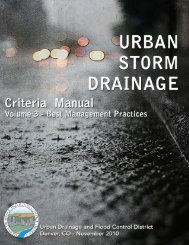Hydraulic Efficiency of Grate and Curb Inlets - Urban Drainage and ...
Hydraulic Efficiency of Grate and Curb Inlets - Urban Drainage and ...
Hydraulic Efficiency of Grate and Curb Inlets - Urban Drainage and ...
You also want an ePaper? Increase the reach of your titles
YUMPU automatically turns print PDFs into web optimized ePapers that Google loves.
Observed<br />
1<br />
0.9<br />
0.8<br />
0.7<br />
0.6<br />
0.5<br />
0.4<br />
0.3<br />
0.2<br />
0.1<br />
0<br />
1 ft depth<br />
0.5 ft depth<br />
0.33 ft depth<br />
Equal<br />
0 0.1 0.2 0.3 0.4 0.5 0.6 0.7 0.8 0.9 1<br />
Predicted<br />
Figure 5-9: Predicted vs. observed efficiency for Type 16 combination-inlet from empirical equation<br />
Observed<br />
1<br />
0.9<br />
0.8<br />
0.7<br />
0.6<br />
0.5<br />
0.4<br />
0.3<br />
0.2<br />
0.1<br />
0<br />
1 ft depth<br />
0.5 ft depth<br />
0.33 ft depth<br />
Equal<br />
0 0.1 0.2 0.3 0.4 0.5 0.6 0.7 0.8 0.9 1<br />
Predicted<br />
Figure 5-10: Predicted vs. observed efficiency for Type R curb inlet from empirical equation<br />
By developing new equations to predict efficiency, it was possible to further improve<br />
predictions for inlet efficiency over previous sections. With new equations presented here, the<br />
average error in predicted efficiency was reduced to about 5% for all inlets with R 2 values<br />
between 0.84 <strong>and</strong> 0.90. Overall agreement between observed <strong>and</strong> predicted efficiency is<br />
improved over previous methods for all test depths. A comparison is shown in Figure 5-11<br />
through Figure 5-13 between the empirical equations <strong>and</strong> the improved UDFCD methods.<br />
66
















